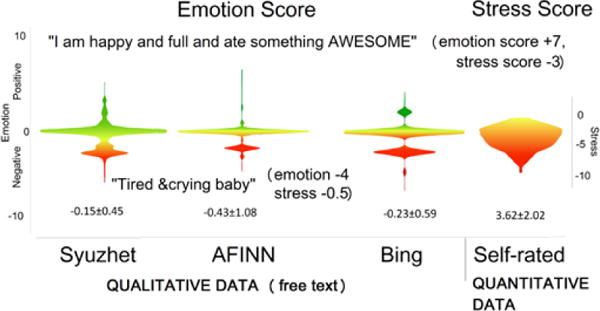Abstract
To visualize and compare three text analysis algorithms of sentiment (AFINN, Bing, Syuzhet), applied to 1549 ecologically assessed self-report stress notes obtained by smartphone, in order to gain insights about stress measurement and management.
Keywords: natural language processing
Introduction
Psychological stress is linked to all six of the most common causes of death in the U.S. In psychology, content analysis methods derived from paper-and-pencil surveys have been applied to patient records to improve mental health outcomes. With the advance of technology, there is an increasing volume of patient generated free-text data reporting mental health symptoms and context. As a result, natural language processing-computer lingustics has been successfully applied to patient-generated free-text to gain insights from symptom and emotion management. A sentiment analysis package, ‘Syuzhet’, for processing free-text data has recently become publicly available. However, few studies have applied this package to free-text stress notes or diaries extracted from smartphone-based ecological momentary assessments [1].
This study aims to visualize and compare three algorithms for sentiment analysis (Syuzhet, AFINN, Bing) applied to 1549 ecologically assessed self-report stress notes using smartphones to gain insights into how the analysis of large volumes of stress diaries might inform emotion management.
Methods
We extracted 1549 free-text notes describing self-reported momentary stressful occurrences, which were collected daily from Jan 2014 to April 2015 from sixty participants. Natural language processing was applied using three sentiment analysis algorithms (Syuzhet, AFINN, Bing) [1]. Pearson correlations were calculated between each algorithm and the participant’s concurrently self-reported stress rating (0–10 scale).
Results
Figure 1 displays the pooled emotion scores from 1549 stress notes, each applying a different sentiment analysis. Pearson correlation coefficients among the three algorithms and self-rated stress scores are shown in Table 1. The correlations among the three algorithms are moderately high, but the correlations of algorithm scores with self-ratings are low. Positive emotion (lack of negative feeling) was deteced from half of the corpora of stress notes. (e.g., “Excitement!” Syuzhet emotion score +1, Self-report stress score −4).
Figure 1.

Visualization of Distribution of Emotion Scores of Daily Stress Notes applying Different Algorithms
Table 1.
Correlations among Three Sentiment Algorithms
| Algorithms | Syuzhet | AFINN | Bing |
|---|---|---|---|
| Syuzhet | 1 | ||
| AFINN | 0.73** | 1 | |
| Bing | 0.83** | 0.67** | 1 |
| Self-Report Score | 0.04 | 0.03 | 0.03 |
p< 0.01, N=1549 notes
Conclusion
Application of sentiment analysis natural language processing and visualization techiques provide insights for research teams regarding large volumes of daily self-report stress notes. The positive emotion scores detected by sentiment analysis algorithms from qualitative data (free text) provide quantified descriptive contextual information on low level self-rated stress scores.
Acknowledgments
National Institute of Health grant # R01 HL115941; NSF Institute for Pure and Applied Mathematics
References
- 1.Jockers M. Package Syuzhet. 2016 V 1.0. [Google Scholar]


